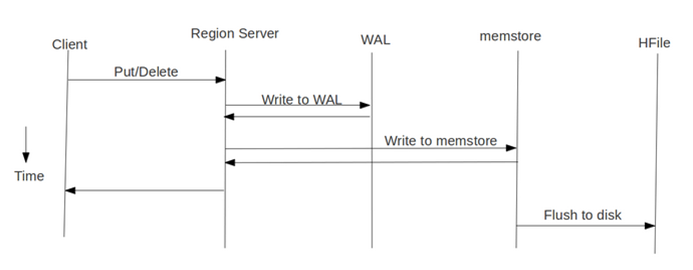1、为何要 BulkLoad 导入?传统的 HTableOutputFormat 写 HBase 有什么问题?
我们先看下 HBase 的写流程:
Image may be NSFW.
Clik here to view.
通常 MapReduce 在写HBase时使用的是 TableOutputFormat 方式,在reduce中直接生成put对象写入HBase,该方式在大数据量写入时效率低下(HBase会block写入,频繁进行flush,split,compact等大量IO操作),并对HBase节点的稳定性造成一定的影响(GC时间过长,响应变慢,导致节点超时退出,并引起一系列连锁反应),而HBase支持 bulk load 的入库方式,它是利用hbase的数据信息按照特定格式存储在hdfs内这一原理,直接在HDFS中生成持久化的HFile数据格式文件,然后上传至合适位置,即完成巨量数据快速入库的办法。配合mapreduce完成,高效便捷,而且不占用region资源,增添负载,在大数据量写入时能极大的提高写入效率,并降低对HBase节点的写入压力。
通过使用先生成HFile,然后再BulkLoad到Hbase的方式来替代之前直接调用HTableOutputFormat的方法有如下的好处:
(1)消除了对HBase集群的插入压力
(2)提高了Job的运行速度,降低了Job的执行时间
目前此种方式仅仅适用于只有一个列族的情况,在新版 HBase 中,单列族的限制会消除。
2、bulkload 流程与实践
bulkload 方式需要两个Job配合完成:(1)第一个Job还是运行原来业务处理逻辑,处理的结果不直接调用HTableOutputFormat写入到HBase,而是先写入到HDFS上的一个中间目录下(如 middata)
(2)第二个Job以第一个Job的输出(middata)做为输入,然后将其格式化HBase的底层存储文件HFile
(3)调用BulkLoad将第二个Job生成的HFile导入到对应的HBase表中
下面给出相应的范例代码:
1 2 3 4 5 6 7 8 9 10 11 12 13 14 15 16 17 18 19 20 21 22 23 24 25 26 27 28 29 30 31 32 33 34 35 36 37 38 39 40 41 42 43 44 45 46 47 48 49 50 51 52 53 54 55 56 57 58 59 60 61 62 63 64 65 66 67 68 69 70 71 72 73 74 75 76 77 78 79 80 81 82 83 84 85 86 87 88 89 90 91 92 93 94 95 96 97 98 99 100 101 102 103 104 105 106 107 108 109 110 111 112 113 114 115 116 117 118 119 120 121 122 123 124 125 126 127 128 129 130 131 132 133 134 135 136 137 138 139 140 141 142 143 144 | importjava.io.IOException;importorg.apache.hadoop.conf.Configuration;importorg.apache.hadoop.fs.Path;importorg.apache.hadoop.hbase.HBaseConfiguration;importorg.apache.hadoop.hbase.KeyValue;importorg.apache.hadoop.hbase.client.HTable;importorg.apache.hadoop.hbase.client.Put;importorg.apache.hadoop.hbase.io.ImmutableBytesWritable;importorg.apache.hadoop.hbase.mapreduce.HFileOutputFormat;importorg.apache.hadoop.hbase.mapreduce.KeyValueSortReducer;importorg.apache.hadoop.hbase.mapreduce.LoadIncrementalHFiles;importorg.apache.hadoop.hbase.util.Bytes;importorg.apache.hadoop.io.IntWritable;importorg.apache.hadoop.io.LongWritable;importorg.apache.hadoop.io.Text;importorg.apache.hadoop.mapreduce.Job;importorg.apache.hadoop.mapreduce.Mapper;importorg.apache.hadoop.mapreduce.Reducer;importorg.apache.hadoop.mapreduce.lib.input.FileInputFormat;importorg.apache.hadoop.mapreduce.lib.input.TextInputFormat;importorg.apache.hadoop.mapreduce.lib.output.FileOutputFormat;importorg.apache.hadoop.mapreduce.lib.output.TextOutputFormat;importorg.apache.hadoop.util.GenericOptionsParser;publicclassGeneratePutHFileAndBulkLoadToHBase { publicstaticclassWordCountMapper extendsMapper<LongWritable, Text, Text, IntWritable> { privateText wordText=newText(); privateIntWritable one=newIntWritable(1); @Override protectedvoidmap(LongWritable key, Text value, Context context) throwsIOException, InterruptedException { // TODO Auto-generated method stub String line=value.toString(); String[] wordArray=line.split(" "); for(String word:wordArray) { wordText.set(word); context.write(wordText, one); } } } publicstaticclassWordCountReducer extendsReducer<Text, IntWritable, Text, IntWritable> { privateIntWritable result=newIntWritable(); protectedvoidreduce(Text key, Iterable<IntWritable> valueList, Context context) throwsIOException, InterruptedException { // TODO Auto-generated method stub intsum=0; for(IntWritable value:valueList) { sum+=value.get(); } result.set(sum); context.write(key, result); } } publicstaticclassConvertWordCountOutToHFileMapper extendsMapper<LongWritable, Text, ImmutableBytesWritable, Put> { @Override protectedvoidmap(LongWritable key, Text value, Context context) throwsIOException, InterruptedException { // TODO Auto-generated method stub String wordCountStr=value.toString(); String[] wordCountArray=wordCountStr.split("\t"); String word=wordCountArray[0]; intcount=Integer.valueOf(wordCountArray[1]); //创建HBase中的RowKey byte[] rowKey=Bytes.toBytes(word); ImmutableBytesWritable rowKeyWritable=newImmutableBytesWritable(rowKey); byte[] family=Bytes.toBytes("cf"); byte[] qualifier=Bytes.toBytes("count"); byte[] hbaseValue=Bytes.toBytes(count); // Put 用于列簇下的多列提交,若只有一个列,则可以使用 KeyValue 格式 // KeyValue keyValue = new KeyValue(rowKey, family, qualifier, hbaseValue); Put put=newPut(rowKey); put.add(family, qualifier, hbaseValue); context.write(rowKeyWritable, put); } } publicstaticvoidmain(String[] args) throwsException { // TODO Auto-generated method stub Configuration hadoopConfiguration=newConfiguration(); String[] dfsArgs = newGenericOptionsParser(hadoopConfiguration, args).getRemainingArgs(); //第一个Job就是普通MR,输出到指定的目录 Job job=newJob(hadoopConfiguration, "wordCountJob"); job.setJarByClass(GeneratePutHFileAndBulkLoadToHBase.class); job.setMapperClass(WordCountMapper.class); job.setReducerClass(WordCountReducer.class); job.setOutputKeyClass(Text.class); job.setOutputValueClass(IntWritable.class); FileInputFormat.setInputPaths(job, newPath(dfsArgs[0])); FileOutputFormat.setOutputPath(job, newPath(dfsArgs[1])); //提交第一个Job intwordCountJobResult=job.waitForCompletion(true)?0:1; //第二个Job以第一个Job的输出做为输入,只需要编写Mapper类,在Mapper类中对一个job的输出进行分析,并转换为HBase需要的KeyValue的方式。 Job convertWordCountJobOutputToHFileJob=newJob(hadoopConfiguration, "wordCount_bulkload"); convertWordCountJobOutputToHFileJob.setJarByClass(GeneratePutHFileAndBulkLoadToHBase.class); convertWordCountJobOutputToHFileJob.setMapperClass(ConvertWordCountOutToHFileMapper.class); //ReducerClass 无需指定,框架会自行根据 MapOutputValueClass 来决定是使用 KeyValueSortReducer 还是 PutSortReducer //convertWordCountJobOutputToHFileJob.setReducerClass(KeyValueSortReducer.class); convertWordCountJobOutputToHFileJob.setMapOutputKeyClass(ImmutableBytesWritable.class); convertWordCountJobOutputToHFileJob.setMapOutputValueClass(Put.class); //以第一个Job的输出做为第二个Job的输入 FileInputFormat.addInputPath(convertWordCountJobOutputToHFileJob, newPath(dfsArgs[1])); FileOutputFormat.setOutputPath(convertWordCountJobOutputToHFileJob, newPath(dfsArgs[2])); //创建HBase的配置对象 Configuration hbaseConfiguration=HBaseConfiguration.create(); //创建目标表对象 HTable wordCountTable =newHTable(hbaseConfiguration, "word_count"); HFileOutputFormat.configureIncrementalLoad(convertWordCountJobOutputToHFileJob,wordCountTable); //提交第二个job intconvertWordCountJobOutputToHFileJobResult=convertWordCountJobOutputToHFileJob.waitForCompletion(true)?0:1; //当第二个job结束之后,调用BulkLoad方式来将MR结果批量入库 LoadIncrementalHFiles loader = newLoadIncrementalHFiles(hbaseConfiguration); //第一个参数为第二个Job的输出目录即保存HFile的目录,第二个参数为目标表 loader.doBulkLoad(newPath(dfsArgs[2]), wordCountTable); //最后调用System.exit进行退出 System.exit(convertWordCountJobOutputToHFileJobResult); }} |
比如原始的输入数据的目录为:/rawdata/test/wordcount/20131212
中间结果数据保存的目录为:/middata/test/wordcount/20131212最终生成的HFile保存的目录为:/resultdata/test/wordcount/20131212
运行上面的Job的方式如下:
hadoop jar test.jar /rawdata/test/wordcount/20131212 /middata/test/wordcount/20131212 /resultdata/test/wordcount/20131212
3、说明与注意事项:
(1)HFile方式在所有的加载方案里面是最快的,不过有个前提——数据是第一次导入,表是空的。如果表中已经有了数据。HFile再导入到hbase的表中会触发split操作。
(2)最终输出结果,无论是map还是reduce,输出部分key和value的类型必须是: < ImmutableBytesWritable, KeyValue>或者< ImmutableBytesWritable, Put>。
否则报这样的错误:
1 2 3 | java.lang.IllegalArgumentException: Can't read partitions file...Caused by: java.io.IOException: wrong key class: org.apache.hadoop.io.*** is not classorg.apache.hadoop.hbase.io.ImmutableBytesWritable |
1 2 3 4 5 6 7 | if(KeyValue.class.equals(job.getMapOutputValueClass())) { job.setReducerClass(KeyValueSortReducer.class);} elseif(Put.class.equals(job.getMapOutputValueClass())) { job.setReducerClass(PutSortReducer.class);} else{ LOG.warn("Unknown map output value type:"+ job.getMapOutputValueClass());} |
(5) MR例子中最后生成HFile存储在HDFS上,输出路径下的子目录是各个列族。如果对HFile进行入库HBase,相当于move HFile到HBase的Region中,HFile子目录的列族内容没有了。
(6)最后一个 Reduce 没有 setNumReduceTasks 是因为,该设置由框架根据region个数自动配置的。
(7)下边配置部分,注释掉的其实写不写都无所谓,因为看源码就知道configureIncrementalLoad方法已经把固定的配置全配置完了,不固定的部分才需要手动配置。
1 2 3 4 5 6 7 8 9 10 11 12 13 14 15 16 17 18 19 20 21 22 23 24 25 26 27 28 29 30 31 32 33 34 35 36 37 38 39 40 41 42 43 44 45 | publicclassHFileOutput { //job 配置 publicstaticJob configureJob(Configuration conf) throwsIOException { Job job = newJob(configuration, "countUnite1"); job.setJarByClass(HFileOutput.class); //job.setNumReduceTasks(2); //job.setOutputKeyClass(ImmutableBytesWritable.class); //job.setOutputValueClass(KeyValue.class); //job.setOutputFormatClass(HFileOutputFormat.class); Scan scan = newScan(); scan.setCaching(10); scan.addFamily(INPUT_FAMILY); TableMapReduceUtil.initTableMapperJob(inputTable, scan, HFileOutputMapper.class, ImmutableBytesWritable.class, LongWritable.class, job); //这里如果不定义reducer部分,会自动识别定义成KeyValueSortReducer.class 和PutSortReducer.class job.setReducerClass(HFileOutputRedcuer.class); //job.setOutputFormatClass(HFileOutputFormat.class); HFileOutputFormat.configureIncrementalLoad(job, newHTable( configuration, outputTable)); HFileOutputFormat.setOutputPath(job, newPath()); //FileOutputFormat.setOutputPath(job, new Path()); //等同上句 returnjob; } publicstaticclassHFileOutputMapper extends TableMapper<ImmutableBytesWritable, LongWritable> { publicvoidmap(ImmutableBytesWritable key, Result values, Context context) throwsIOException, InterruptedException { //mapper逻辑部分 context.write(newImmutableBytesWritable(Bytes()), LongWritable()); } } publicstaticclassHFileOutputRedcuer extends Reducer<ImmutableBytesWritable, LongWritable, ImmutableBytesWritable, KeyValue> { publicvoidreduce(ImmutableBytesWritable key, Iterable<LongWritable> values, Context context) throwsIOException, InterruptedException { //reducer逻辑部分 KeyValue kv = newKeyValue(row, OUTPUT_FAMILY, tmp[1].getBytes(), Bytes.toBytes(count)); context.write(key, kv); } }} |
4、Refer:
1、Hbase几种数据入库(load)方式比较
http://blog.csdn.net/kirayuan/article/details/6371635
2、MapReduce生成HFile入库到HBase及源码分析
http://blog.pureisle.net/archives/1950.html
3、MapReduce生成HFile入库到HBase
已有 0人发表留言,猛击->> 这里<<-参与讨论
ITeye推荐